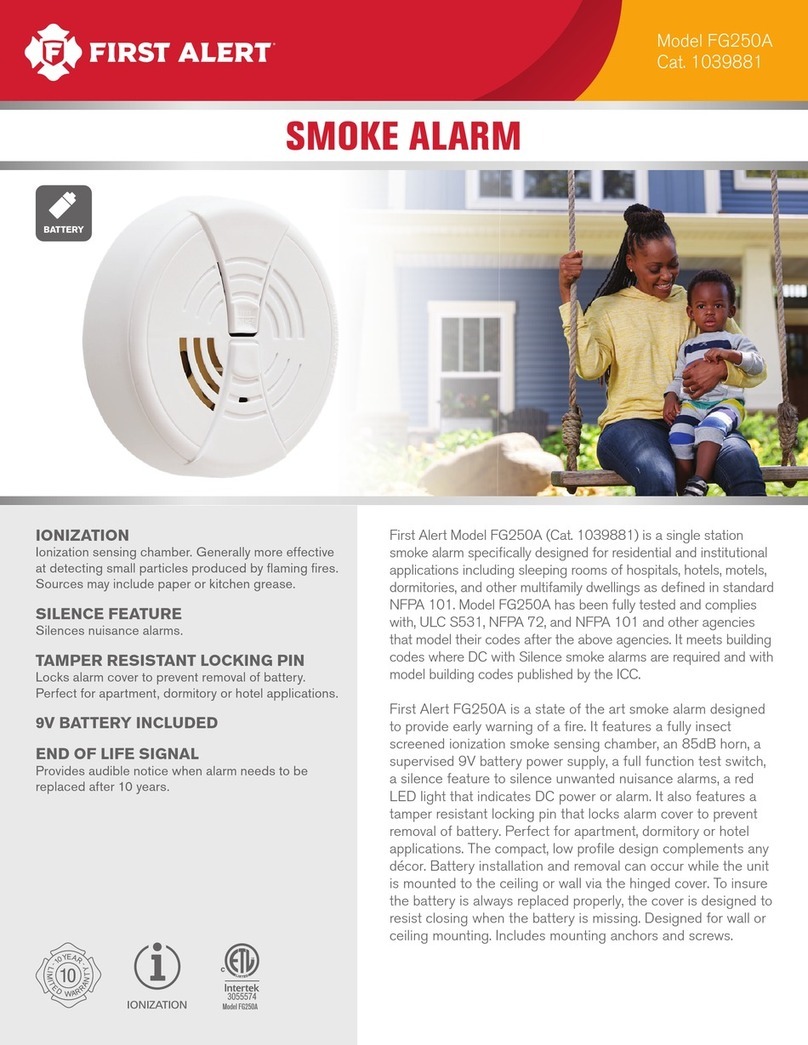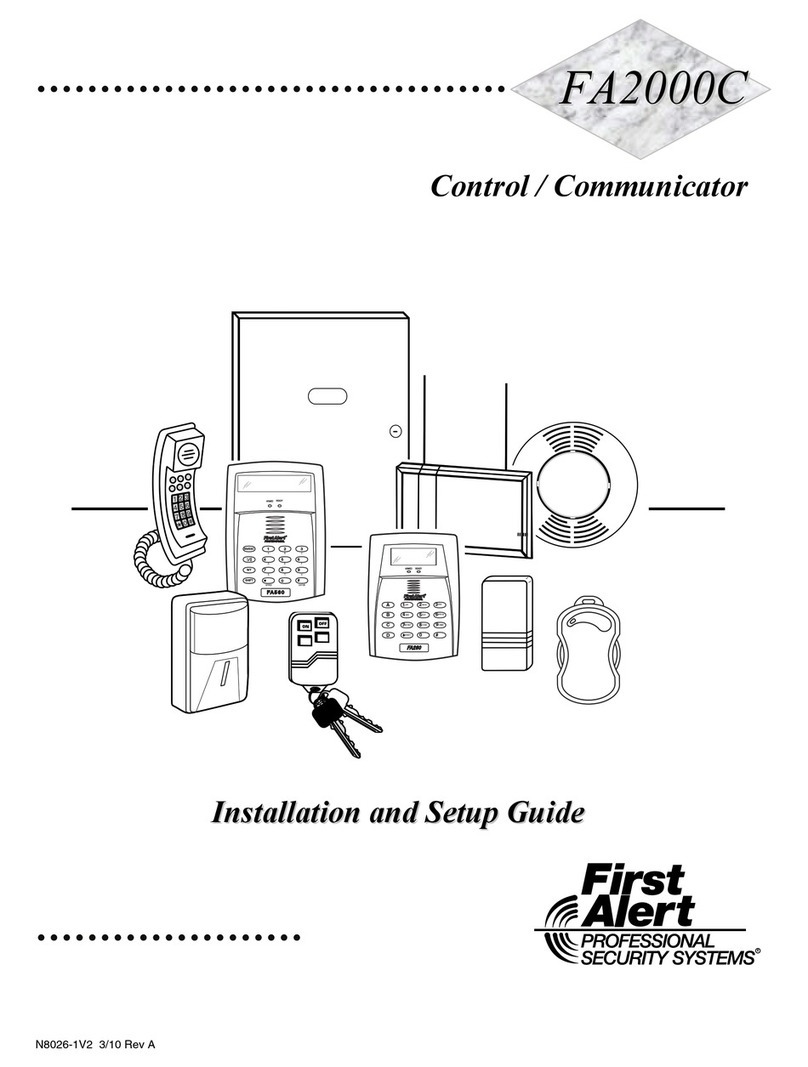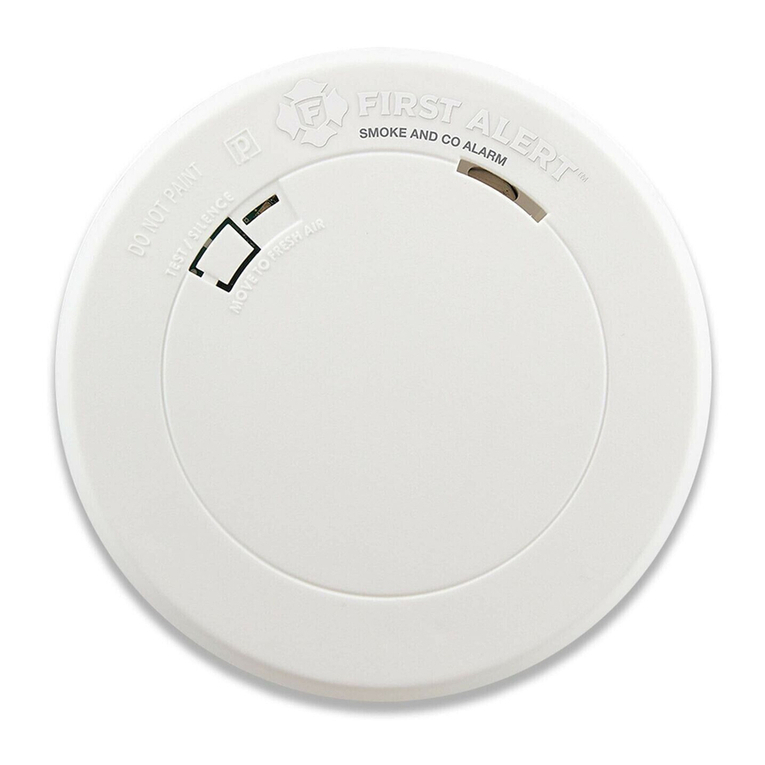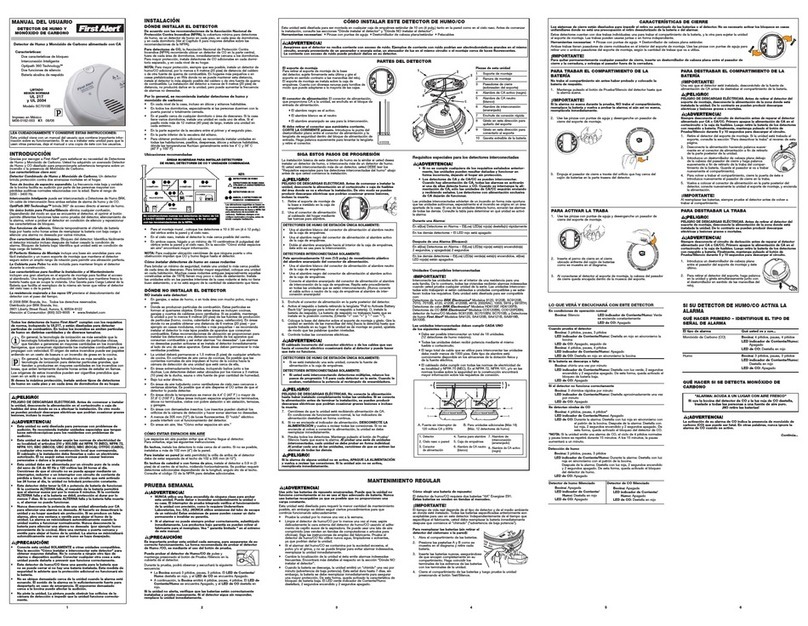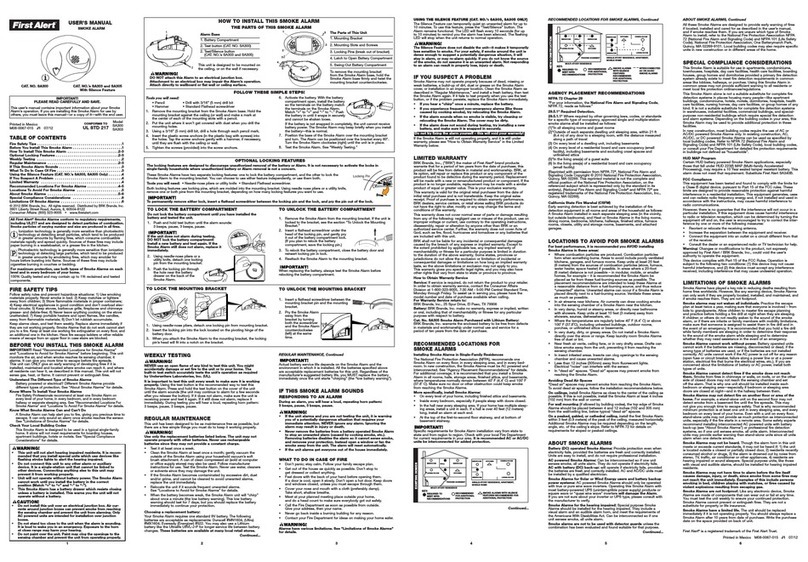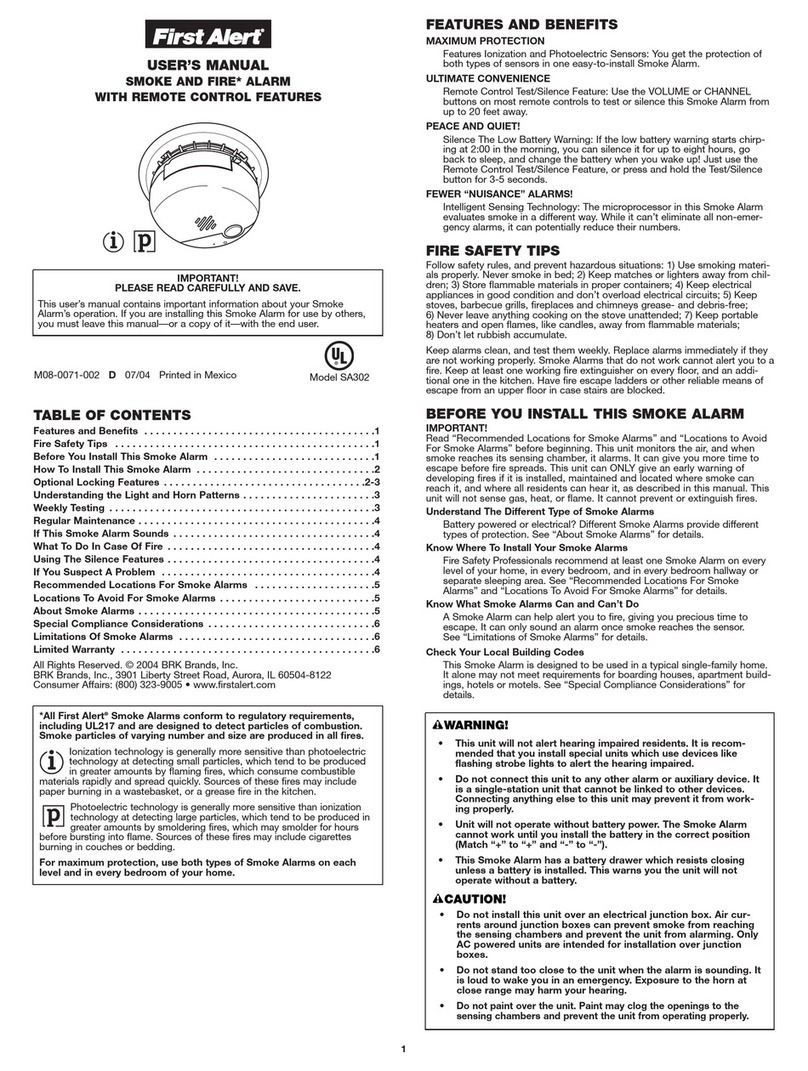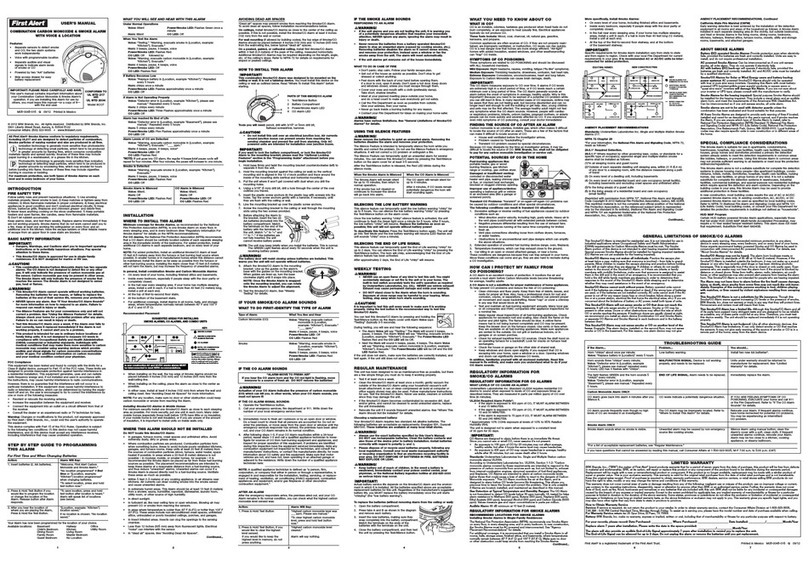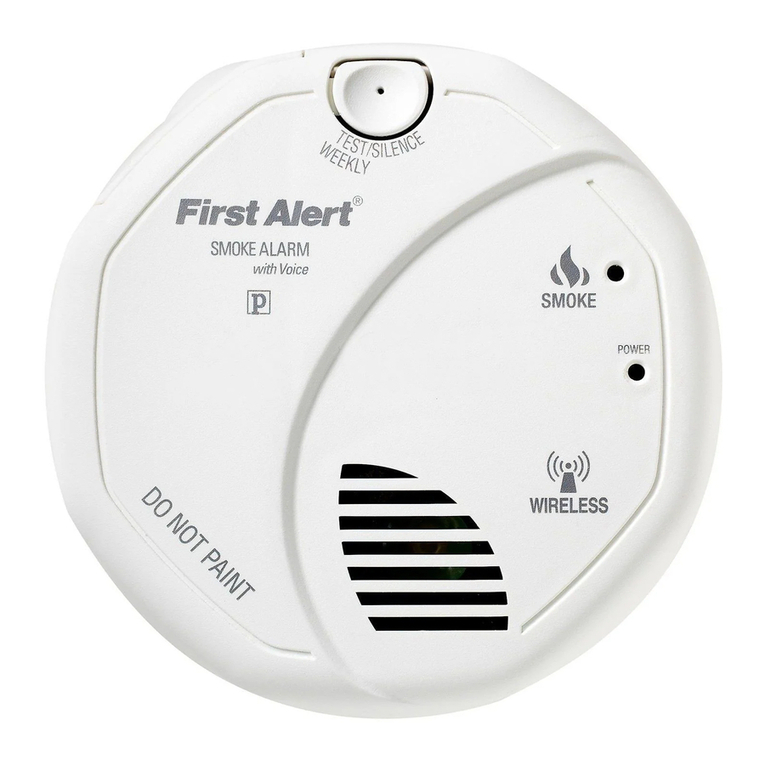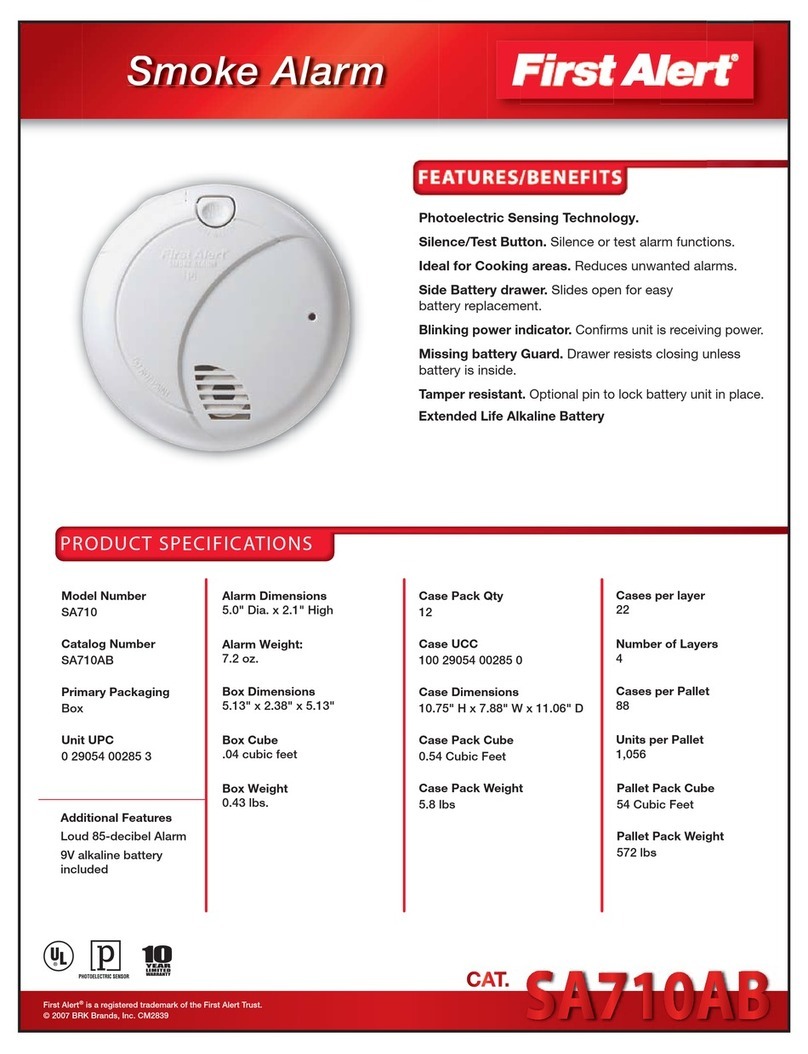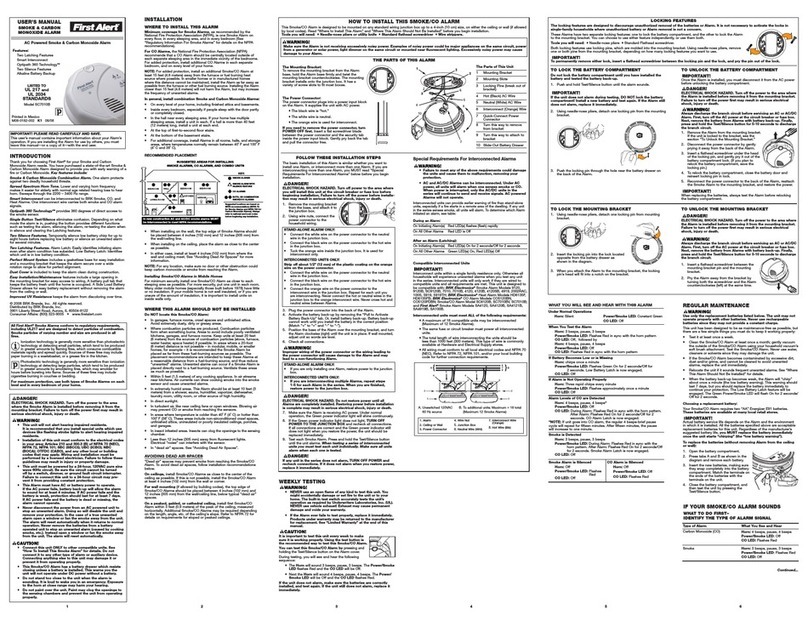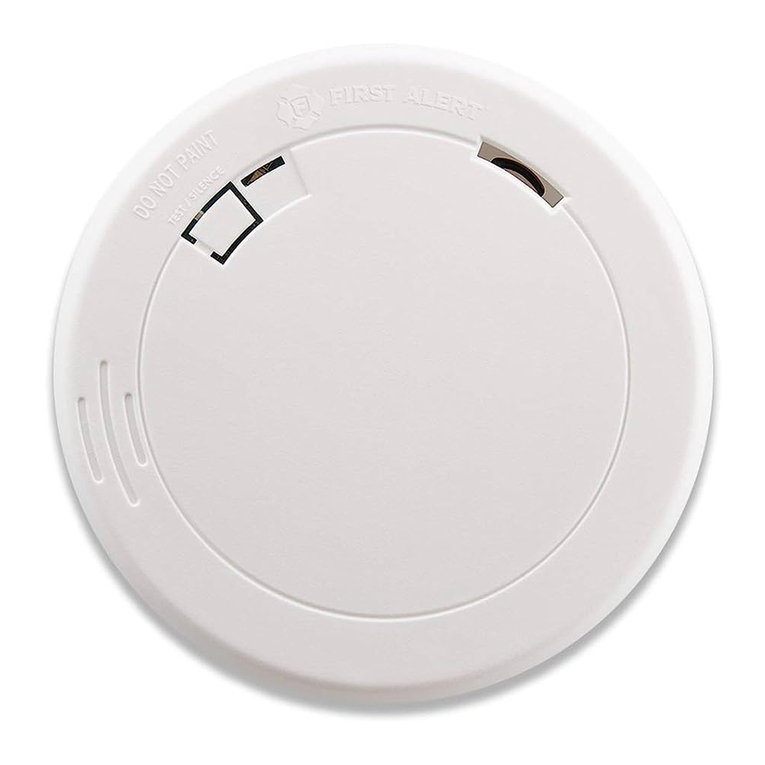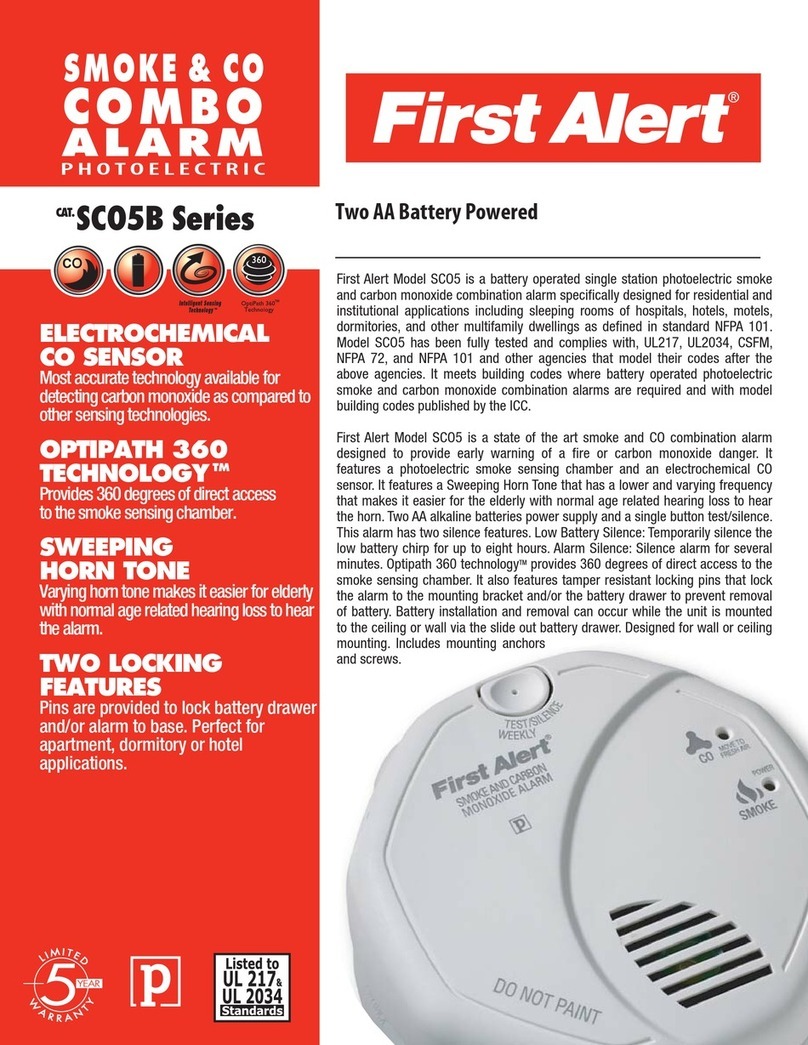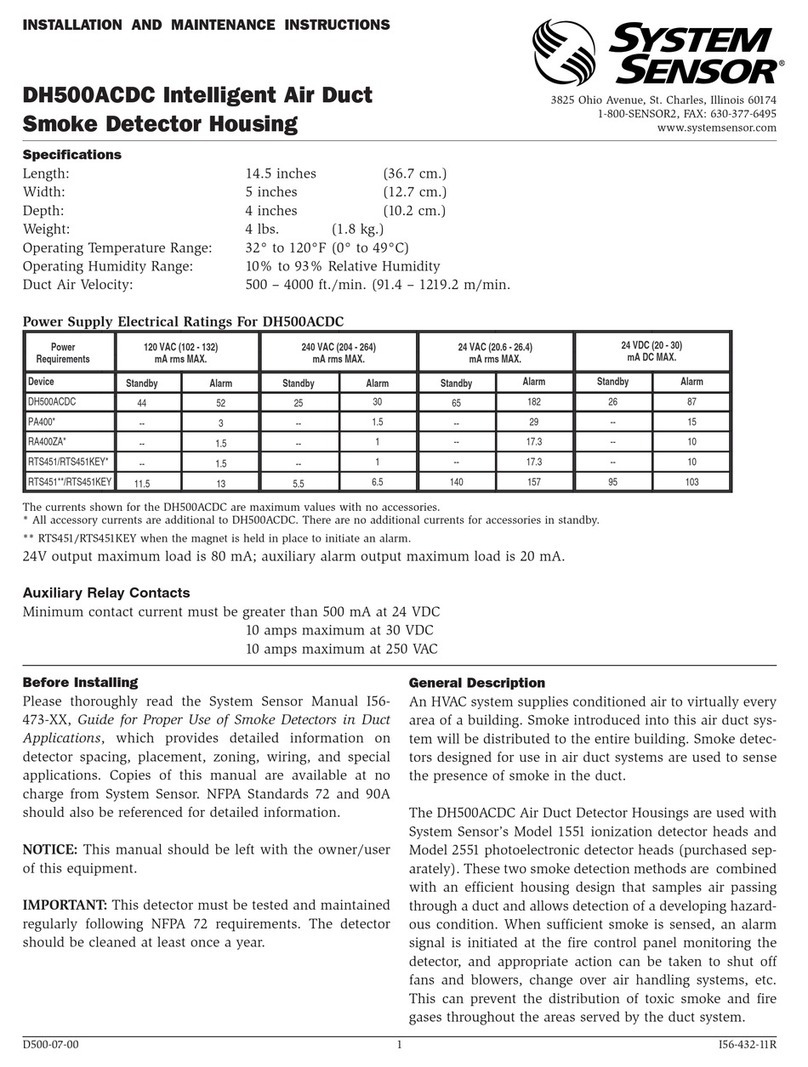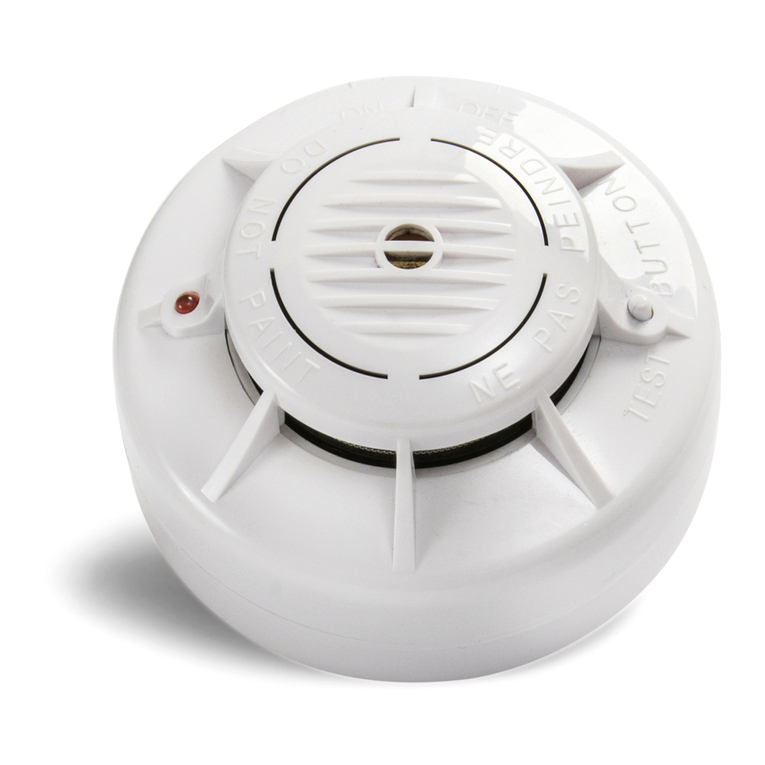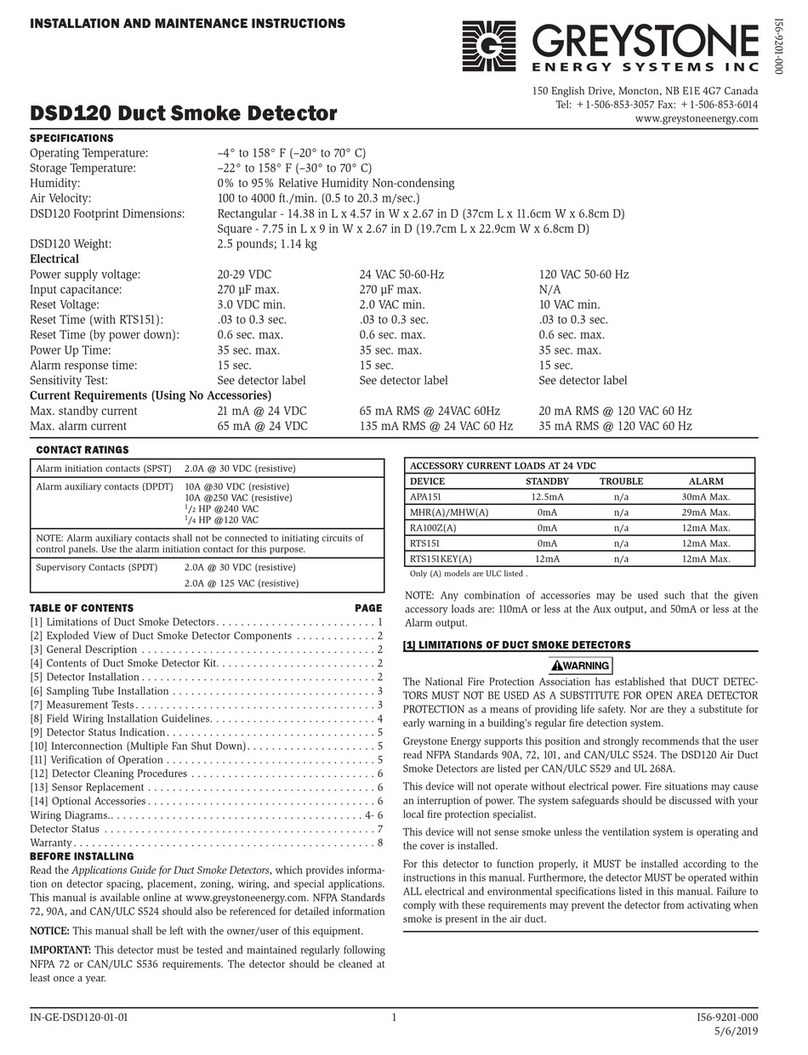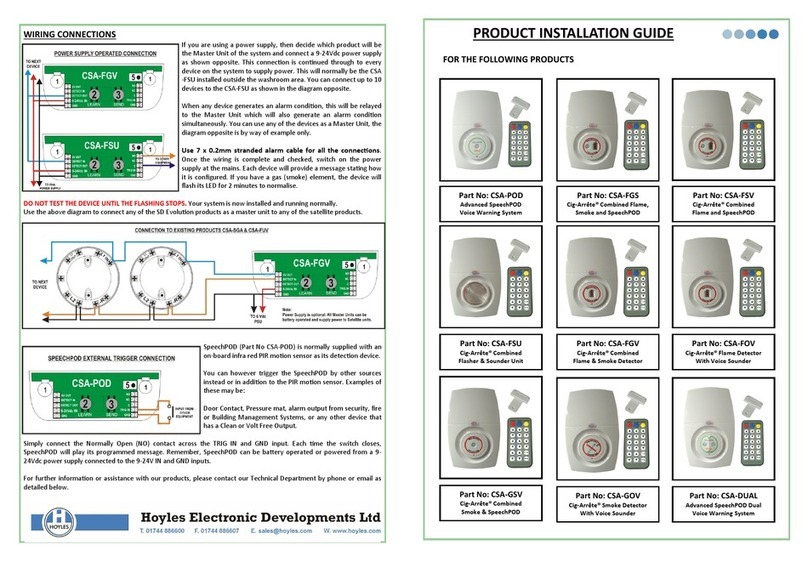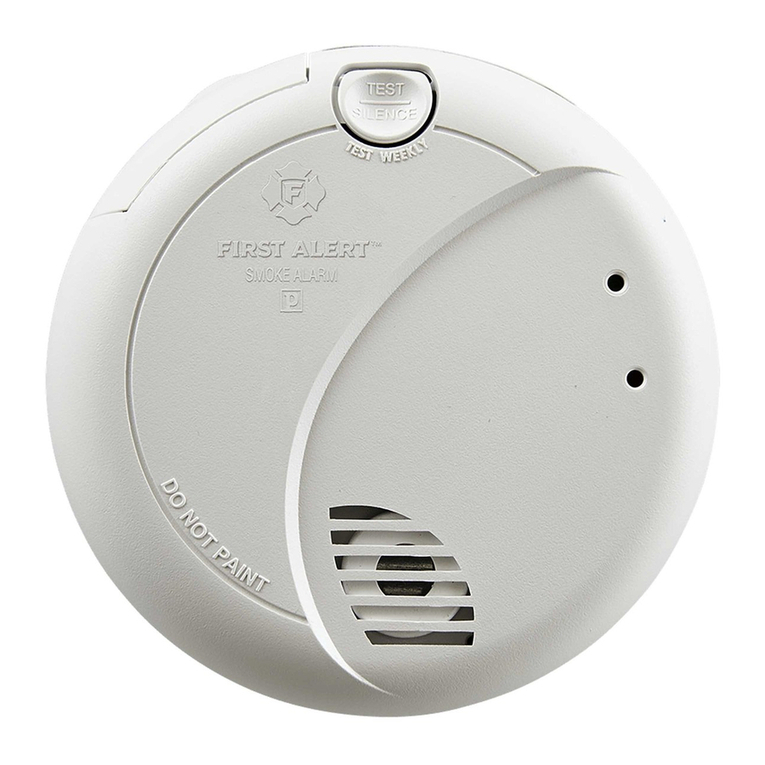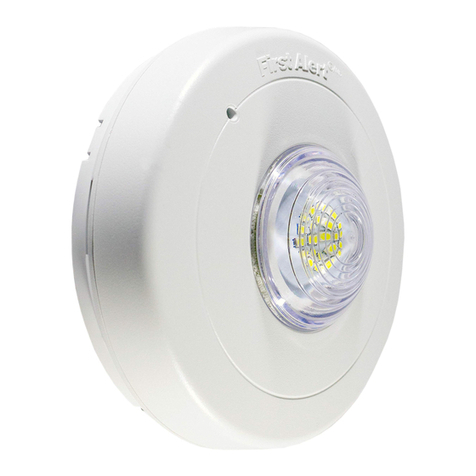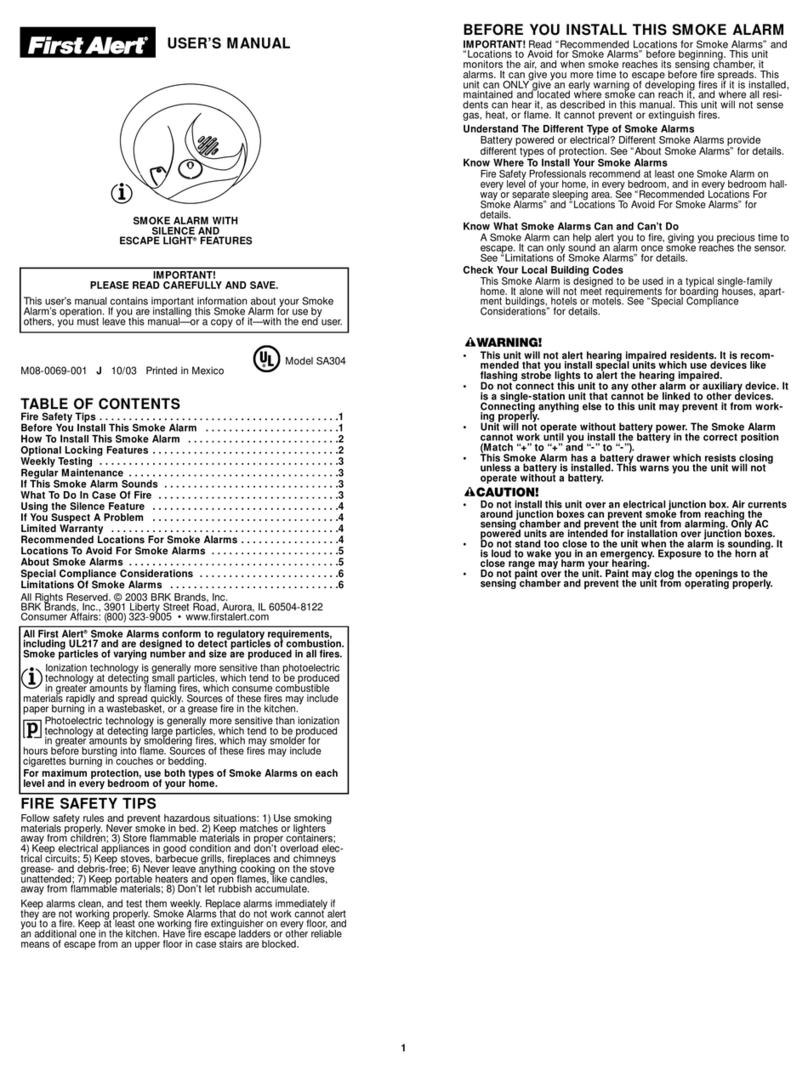
7 8
Printed in Mexico M08-0094-014 K1 09/10
BRK Electronics®is a registered trademark of BRK Brands, Inc.
First Alert®is a registered trademark of the First Alert Trust.
910 11 12
WEEKLY TESTING
•NEVER use an open flame of any kind to test this unit. You
might accidentally damage or set fire to the unit or to your
home. The built-in test switch accurately tests the unit’s
operation as required by Underwriters Laboratories, Inc. (UL).
NEVER use vehicle exhaust! Exhaust may cause permanent
damage and voids your warranty.
•DO NOT stand close to the Alarm when the horn is sounding.
Exposure at close range may be harmful to your hearing.
When testing, step away when horn starts sounding.
It is important to test this unit every week to make sure it is working
properly. Using the test button is the recommended way to test this
Smoke/CO Alarm.
1. Push and hold the Test/Silence button on the cover until you hear a
“chirp.” The “chirp” marks the start of the self-test sequence.
2. During testing, you will hear a loud, repeating horn pattern: 3 beeps,
pause, 3 beeps, pause, while the red smoke LED flashes. Then you
will hear a loud, repeating horn pattern: 4 beeps, pause, 4 beeps,
pause, while the red CO LED flashes.
If the Smoke/CO Alarm does not test properly:
1. Make sure the battery is fresh and installed correctly.
2. Be sure the alarm is clean and dust-free.
3. Test the unit again.
Ifthe Smoke/CO Alarm is still not working properly, replace it immediately.
Refer to the “Limited Warranty” at the end of this manual.
Ifthere is still a problem, do not try to fix the Alarm yourself.
This will void your warranty!
REGULAR MAINTENANCE
Use only the replacement batteries listed below. The unit may not
operate properly with other batteries. Never use rechargeable
batteries since they may not provide a constant charge.
This unit has been designed to be as maintenance-free as possible, but
there are a few simple things you must do to keep it working properly:
•Test it at least once a week.
•Clean the Smoke/CO Alarm at least once a month; gently vacuum
the outside of the Smoke/CO Alarm using your household vacuum’s
soft brush attachment. Test the Smoke/CO Alarm. Never use water,
cleaners or solvents since they may damage the unit.
•If the Smoke/CO Alarm becomes contaminated by excessive dirt,
dust and/or grime, and cannot be cleaned to avoid unwanted
alarms, replace the unit immediately.
•Relocate the unit if it sounds frequent unwanted alarms. See “Where
This Alarm Should Not Be Installed” for details.
•When the battery becomes weak, the Alarm will “chirp” about once
aminute (the low battery warning). This warning should last 7 days,
but you should replace the battery immediately to continue your
protection. This Alarm must have battery power to operate.
Ifthe batteryis dead or missing, the Alarm cannot operate.
DO NOT spray cleaning chemicals or insect sprays directly on or near
the Alarm. DO NOT paint over the Alarm. Doing so may permanently
damage the Alarm.
CHOOSING A REPLACEMENT BATTERY:
This Smoke/CO Alarm requires one standard9V alkaline battery.The
following alkaline batteries are acceptable as replacements: Duracell
#MN1604 or MX1604; Eveready “Energizer” 522. You can also use an
Ultralife 9V lithium battery #U9VL for longer service life between battery
changes. These batteries areavailable at many local retail stores.
Actual battery service life depends on the Smoke/CO Alarm and the
environment in which it is installed. All the batteries specified above
areacceptable replacement batteries for this unit. Regardless of the
manufacturer’s suggested battery life, you MUST replace the battery
immediately once the unit starts “chirping” (the “low battery warning”).
WHATYOU NEED TO KNOW ABOUT CO
WHAT IS CO?
CO is an invisible, odorless, tasteless gas produced when fossil fuels
donot burncompletely,or areexposed to heat (usually fire). Electrical
appliances typically do not produce CO.
These fuels include: Wood, coal, charcoal, oil, natural gas, gasoline,
kerosene, and propane.
Common appliances areoften sources of CO. If they are not properly
maintained, are improperly ventilated, or malfunction, CO levels can rise
quickly.CO is a real danger now that homes are more energy efficient.
“Air-tight” homes with added insulation, sealed windows, and other
weatherproofing can “trap” CO inside.
SYMPTOMS OF CO POISONING
These symptoms are related to CO POISONING and should be
discussed with ALL household members.
Mild Exposure:Slight headache, nausea, vomiting, fatigue (“flu-like”
symptoms).
Medium Exposure: Throbbing headache, drowsiness, confusion, fast
heart rate.
Extreme Exposure: Convulsions, unconsciousness, heart and lung
failure. Exposureto Carbon Monoxide can cause brain damage, death.
This CO Alarm measures exposure to CO over time. It alarms if CO
levels are extremely high in a short period of time, or if CO levels reach
acertain minimum over a long period of time. The CO Alarm generally
sounds an alarm beforethe onset of symptoms in average, healthy
adults.
POTENTIAL SOURCES OF CO IN THE HOME
Fuel-burning appliances like: portable heater, gas or wood burning
fireplace, gas kitchen range or cooktop, gas clothes dryer.
Damaged or insufficient venting: corroded or disconnected water
heater vent pipe, leaking chimney pipe or flue, or cracked heat
exchanger, blocked or clogged chimney opening.
Improper use of appliance/device: operating a barbecue grill or
vehicle in an enclosed area (like a garage or screened porch).
Transient CO Problems: “transient” or on-again-off-again CO problems
can be caused by outdoor conditions and other special circumstances.
The following conditions can result in transient CO situations:
1. Excessive spillage or reverse venting of fuel appliances caused by
outdoor conditions such as:
•Wind direction and/or velocity, including high, gusty winds. Heavy
air in the vent pipes (cold/humid air with extended periods
between cycles).
•Negative pressure differential resulting from the use of exhaust
fans.
•Several appliances running at the same time competing for limited
fresh air.
•Vent pipe connections vibrating loose from clothes dryers,
furnaces, or water heaters.
•Obstructions in or unconventional vent pipe designs which can
amplify the above situations.
2. Extended operation of unvented fuel burning devices (range, oven,
fireplace).
3. Temperature inversions, which can trap exhaust close to the ground.
4. Car idling in an open or closed attached garage, or near a home.
These conditions are dangerous because they can trap exhaust in your
home. Since these conditions can come and go, they are also hard to
recreate during a CO investigation.
HOW CAN I PROTECT MY FAMILY FROM CO
POISONING?
ACO Alarm is an excellent means of protection. It monitors the air
and sounds a loud alarm before Carbon Monoxide levels become
threatening for average, healthy adults.
ACO Alarm is not a substitute for proper maintenance of home
appliances.
Tohelp prevent CO problems and reduce the risk of CO poisoning:
•Clean chimneys and flues yearly. Keep them free of debris, leaves,
and nests for proper air flow. Also, have a professional check for
rust and corrosion, cracks, or separations. These conditions can
prevent proper air movement and cause backdrafting. Never “cap”
orcover a chimney in any way that would block air flow.
•Test and maintain all fuel-burning equipment annually. Many local
gas or oil companies and HVAC companies offer appliance
inspections for a nominal fee.
•Make regular visual inspections of all fuel-burning appliances.
Check appliances for excessive rust and scaling. Also check the
flame on the burner and pilot lights. The flame should be blue.
Ayellow flame means fuel is not being burned completely and
COmay be present. Keep the blower door on the furnace closed.
Use vents or fans when they are available on all fuel-burning
appliances. Make sure appliances are vented to the outside. Do
not grill or barbecue indoors, or in garages or on screen porches.
•Check for exhaust backflow from CO sources. Check the draft
hood on an operating furnace for a backdraft. Look for cracks on
furnace heat exchangers.
•Check the house or garage on the other side of shared wall.
•Keep windows and doors open slightly. If you suspect that CO
is escaping into your home, open a window or a door. Opening
windows and doors can significantly decrease CO levels.
In addition, familiarize yourself with all enclosed materials. Read
this manual in its entirety,and make sureyou understand what to
doif your CO Alarmsounds.
REGULATORY INFORMATION FOR
SMOKE/CO ALARMS
REGULATORY
INFORMATION FOR CO ALARMS
WHAT LEVELS OF CO CAUSE AN ALARM?
Underwriters Laboratories Inc. Standard UL2034 requires residential CO
Alarms to sound when exposed to levels of CO and exposure times as
described below.They aremeasuredin parts per million (ppm) of CO
over time (in minutes).
UL2034 Required AlarmPoints*:
•If the alarm is exposed to 400 ppm of CO, IT MUST ALARM
BETWEEN 4 and 15 MINUTES.
•If the alarm is exposed to 150 ppm of CO, IT MUST ALARM
BETWEEN 10 and 50 MINUTES.
•If the alarm is exposed to 70 ppm if CO, IT MUST ALARM
BETWEEN 60 and 240 MINUTES.
*Approximately 10% COHb exposure at levels of 10% to 95% Relative
Humidity (RH).
The unit is designed not to alarm when exposed to a constant level
of 30 ppm for 30 days.
CO Alarms aredesigned to alarm beforethere is an immediate life threat.
Since you cannot see or smell CO, never assume it’snot present.
•An exposureto 100 ppm of CO for 20 minutes may not affect
average, healthy adults, but after 4 hours the same level may
cause headaches.
• An exposure to 400 ppm of CO may cause headaches in average,
healthy adults after 35 minutes, but can cause death after 2 hours.
Standards: Underwriters Laboratories Inc. Single and Multiple Station
carbon monoxide alarms UL2034.
According to Underwriters Laboratories Inc. UL2034, Section 1-1.2:
“Carbon monoxide alarms covered by these requirements are intended
to respond to the presence of carbon monoxide from sources such as,
but not limited to, exhaust from internal-combustion engines, abnormal
operation of fuel-fired appliances, and fireplaces. CO Alarms are
intended to alarm at carbon monoxide levels below those that could
cause a loss of ability to react to the dangers of Carbon Monoxide
exposure.” This CO Alarm monitors the air at the Alarm, and is
designed to alarm before CO levels become life threatening. This
allows you precious time to leave the house and correct the problem.
This is only possible if Alarms are located, installed, and maintained as
described in this manual.
Gas Detection at Typical Temperature and Humidity Ranges: The CO
Alarm is not formulated to detect CO levels below 30 ppm typically.
Audible Alarm: 85 dB minimum at 10 feet (3 meters).
ABOUT SMOKE ALARMS
Battery (DC) operated Smoke Alarms: Provide protection even when
electricity fails, provided the batteries are fresh and correctly installed.
Units areeasy to install, and do not require professional installation.
However, they do not provide interconnected functionality.
AC powered Smoke Alarms: Can be interconnected so if one unit
senses smoke, all units alarm. They do not operate if electricity fails.
AC with battery (DC) back-up: will operate if electricity fails, provided
the batteries arefresh and correctly installed. AC and AC/DC units
must be installed by a qualified electrician.
Wireless Interconnected Alarms: Offer the same interconnected
functionality as with hardwired alarms, without wires. Units are easy
to install and do not require professional installation. They provide
protection even when electricity fails, provided the batteries are fresh
and correctly installed.
Smoke Alarms for Solar or Wind Energy users and battery backup
power systems: AC powered Smoke Alarms should only be operated
with true or pure sine wave inverters. Operating this Smoke Alarm with
most battery-powered UPS (uninterruptible power supply) products or
square wave or “quasi sine wave” inverters will damage the Alarm.
If you are not sure about your inverter or UPS type, please consult with
the manufacturer to verify.
Smoke Alarms for the hearing impaired: Special purpose Smoke
Alarms should be installed for the hearing impaired. They include a
visual alarm and an audible alarm horn, and meet the requirements of
the Americans With Disabilities Act. These units can be interconnected
so if one unit senses smoke, all units alarm.
Smoke alarms arenot to be used with detector guards unless the
combination has been evaluated and found suitable for that purpose.
All these Smoke Alarms are designed to provide early warning of fires if
located, installed and cared for as described in the user’s manual, and if
smoke reaches the Alarm. If you areunsure which type of unit to install,
refer to NFPA(National FireProtection Association) 72 (National Fire
Alarm Code) and NFPA 101 (Life Safety Code). National Fire Protection
Association, One Batterymarch Park, Quincy, MA 02269-9101.
Local
building codes may also require specific units in new construction
or in different areas of the home.
SPECIAL COMPLIANCE CONSIDERATIONS
This unit alone is not a suitable substitute for complete fire
detection systems in places housing many people—like apartment
buildings, condominiums, hotels, motels, dormitories, hospitals,
long-term health care facilities, nursing homes, day care facilities,
or group homes of any kind—even if they were once single-family
homes. It is not a suitable substitute for complete fire detection
systems in warehouses, industrial facilities, commercial buildings,
and special-purpose non-residential buildings which require special
fire detection and alarm systems. Depending on the building codes
inyour area, this unit may be used to provide additional protection
in these facilities.
The following information applies to all four types of buildings listed
below:
In new construction, most building codes require the use of AC or
AC/DC powered Smoke Alarms only. AC, AC/DC, or DC powered
Smoke Alarms can be used in existing construction as specified by
local building codes. Refer to NFPA 72 (National Fire Alarm Code) and
NFPA 101 (Life Safety Code), local building codes, or consult your Fire
Department for detailed fire protection requirements in buildings not
defined as “households.”
1. Single-Family Residence:
Single family home, townhouse. It is recommended this unit be installed
onevery level of the home, in every bedroom, and in each bedroom
hallway.
2. Multi-Family or Mixed Occupant Residence:
Apartment building, condominium. This unit is suitable for use in individual
apartments or condos, provided a primary fire detection system already
exists to meet fire detection requirements in common areas like lobbies,
hallways, or porches. Using this unit in common areas may not provide
sufficient warning to all residents or meet local fire protection ordinances/
regulations.
3.Institutions:
Hospitals, day carefacilities, long-term health care facilities. This unit is
suitable for use in individual patient sleeping/resident rooms, provided
aprimary fire detection system already exists to meet fire detection
requirements in common areas like lobbies, hallways, or porches.
Using this unit in common areas may not provide sufficient warning
to all residents or meet local fire protection ordinances/regulations.
4. Hotels and Motels:
Also boarding houses and dormitories. This unit is suitable for use inside
individual sleeping/resident rooms, provided a primary fire detection
system already exists to meet fire detection requirements in common
areas like lobbies, hallways, or porches. Using this unit in common
areas may not provide sufficient warning to all residents or meet local
fire protection ordinances/regulations.
GENERAL LIMITATIONS OF SMOKE/CO ALARMS
LIMITED WARRANTY
BRK Brands, Inc., ("BRK") the maker of BRK®brand and First Alert®brand products, warrants that for a period of seven years from the date of purchase,
this product will be free from defects in material and workmanship. BRK, at its option, will repair or replace this product or any component of the product
found to be defective during the warranty period. Replacement will be made with a new or remanufacturedproduct or component. If the product is no
longer available, replacement may be made with a similar product of equal or greater value. This is your exclusive warranty.
This warranty is valid for the original retail purchaser from the date of initial retail purchase and is not transferable. Keep the original sales receipt.
Proof of purchase is required to obtain warranty performance. BRK dealers, service centers, or retail stores selling BRK products do not have the right to
alter, modify or any way change the terms and conditions of this warranty.
This warranty does not cover normal wear of parts or damage resulting from any of the following: negligent use or misuse of the product, use on improper
voltage or current, use contrary to the operating instructions, disassembly, repair or alteration by anyone other than BRK or an authorized service center.
Further, the warranty does not cover Acts of God, such as fire, flood, hurricanes and tornadoes or any batteries that are included with this unit.
BRK shall not be liable for any incidental or consequential damages caused by the breach of any express or implied warranty. Except to the extent
prohibited by applicable law, any implied warranty of merchantability or fitness for a particular purpose is limited in duration to the duration of the above
warranty. Some states, provinces or jurisdictions do not allow the exclusion or limitation of incidental or consequential damages or limitations on how long
an implied warranty lasts, so the above limitations or exclusion may not apply to you. This warranty gives you specific legal rights, and you may also have
other rights that vary from state to state or province to province.
How to Obtain Warranty Service
Service: If service is required, do not return the product to your retailer. In order to obtain warranty service, contact the Consumer Affairs Division at
1-800-323-9005, 7:30 AM - 5:00 PM Central Standard Time, Monday through Friday. To assist us in serving you, please have the model number and
date of purchase available when calling.
For Warranty Service returnto: BRK Brands, Inc., 25 Spur Drive, El Paso, TX 79906
Battery: BRK Brands, Inc. make no warranty, express or implied, written or oral, including that of merchantability or fitness for any particular purpose
with respect to battery.
Once a minute, the alarm sounds 3 “chirps”,
and the green light flashes quickly threetimes. MALFUNCTION SIGNAL. Unit needs to be
replaced. Based on self-diagnostic tests, the
unit has detected a fault.
Units under warranty should be returned to
manufacturerfor replacement. See “Limited
Warranty” for details.
The light flashes (GREEN) and the horn sounds
5“chirps” every minute. END OF LIFE SIGNAL.
COAlarm needs to be replaced. Immediately replace the CO Alarm.
Horn "chirps" about once per minute;
Green "Power/Smoke" LED flashes Green On
for 2 seconds/Off for 2 seconds. (Low Battery
Latch is engaged.)
Low battery warning. Battery is low or missing. Replace the battery.
If your Alarmdoes this... It means... You should...
TROUBLESHOOTING GUIDE
Alarm goes back into alarm after you pressed
the Test/Silence button to silence an alarm. Smoke and/or CO levels are still potentially
dangerous. Refer to “If Your Smoke/CO Alarm Sounds” for
details on how to respond to an alarm. If anyone
isfeeling ill, EVACUATE your home immediately
and call 911.
If you have any questions that cannot be answered by reading this manual, call Consumer Affairs: 1-800-323-9005.
*For a list of acceptable replacement batteries, see “Regular Maintenance.”
Alarm sounds frequently even though no high
levels of smoke or CO are revealed in an
investigation.
The Alarm may be improperly located. Refer to
“Where to Install This Alarm.” Relocate your alarm. If frequent alarms continue,
have home rechecked for potential problems.
You may be experiencing an intermittent smoke
orCO problem.
For your records, please record:
Date Purchased: _______________________________
WherePurchased: __________________________________________
Date Installed: ____________/____________Month/Year
Replace alarm 7 years after installation. Please write the date in
the space provided:
_____________/____________Month/Year
The alarm will also provide an audible End-of-Life Signal
approximately 7 years after installation to remind you to
replace the unit.
The End-of-Life Signal can be silenced for up to 2 days.
Do not unplug the alarm or remove the batteries until you get
replacement.
This Smoke/CO Alarm is intended for residential use. It is not intended
for use in industrial applications whereOccupational Safety and Health
Administration (OSHA) requirements for Carbon Monoxide Alarms must
bemet. The Smoke Alarm portion of this device is not intended to alert
hearing impairedresidents. Special purpose Smoke Alarms should be
installed for hearing impaired residents (CO Alarms are not yet available
for the hearing impaired).
Smoke/CO Alarms may not waken all individuals. Practice the
escape plan at least twice a year, making sure that everyone is involved
–from kids to grandparents. Allow children to master fire escape
planning and practice beforeholding a firedrill at night when they are
sleeping. If children or others do not readily waken to the sound of the
Smoke/CO Alarm, or if thereare infants or family members with mobility
limitations, make sure that someone is assigned to assist them in fire
drill and in the event of an emergency. It is recommended that you hold
afiredrill while family members aresleeping in order to determine their
response to the sound of the Smoke/CO Alarm while sleeping and
to determine whether they may need assistance in the event of an
emergency.
Smoke
/CO
Alarms cannot work without power. Battery operated units
cannot work if the batteries aremissing, disconnected or dead, if the wrong
type of batteries are used, or if the batteries are not installed correctly.
ACunits cannot work if the AC power is cut off for any reason (open fuse
orcircuit breaker, failure along a power line or at a power station, electrical
fire that burns the electrical wires, etc.). If you are concerned about the
limitations of battery or AC power, install both types of units.
This Smoke/CO Alarm will not sense smoke or CO that does not
reach the sensors. Itwill only sense smoke or CO at the sensor. Smoke
or CO may be present in other areas. Doors or other obstructions may
affect the rate at which CO or smoke reaches the sensors. If bedroom
doors areusually closed at night, we recommend you install an alarm
device (Combination CO and Smoke Alarm, or separate CO Alarms and
Smoke Alarms) in each bedroom and in the hallway between them.
This Smoke/CO Alarmmay not sense smoke or CO on another
level of the home. Example: This alarm device, installed on the second
floor, may not sense smoke or CO in the basement. For this reason,
one alarm device may not give adequate early warning. Recommended
minimum protection is one alarm device in every sleeping area, every
bedroom, and on every level of your home. Some experts recommend
battery powered Smoke and CO Alarms be used in conjunction with
interconnected AC powered Smoke Alarms. For details, see “About
Smoke Alarms” for details.
Smoke/CO Alarms may not be heard. The alarm horn loudness
meets or exceeds current UL standardsof 85 dB at 10 feet (3 meters).
However, if the Smoke/CO Alarm is installed outside the bedroom, it
may not wake up a sound sleeper or one who has recently used drugs
or has been drinking alcoholic beverages. This is especially true if the
door is closed or only partly open. Even persons who are awake may
not hear the alarm horn if the sound is blocked by distance or closed
doors. Noise from traffic, stereo, radio, television, air conditioner, or
other appliances may also prevent alert persons from hearing the alarm
horn. This Smoke/CO Alarm is not intended for people who are hearing
impaired.
The Alarmmay not have time to alarm before the fire itself causes
damage, injury,or death, since smoke from some fires may not
reach the unit immediately. Examples of this include persons
smoking in bed, children playing with matches, or fires caused
by violent explosions resulting from escaping gas.
This Smoke/CO Alarmis not a substitute for life insurance.
Though this Smoke/CO Alarm warns against increasing CO levels or
the presence of smoke, BRK Brands, Inc. does not warrant or imply in
any way that they will protect lives. Homeowners and renters must still
insuretheir lives.
This Smoke/CO Alarmhas a limited life. Although this Smoke/CO
Alarm and all of its parts have passed many stringent tests and are
designed to be as reliable as possible, any of these parts could fail at
any time. Therefore, you must test this device weekly. The unit should
be replaced immediately if it is not operating properly.
This Smoke/CO Alarm is not foolproof. Like all other electronic
devices, this Smoke/CO Alarm has limitations. It can only detect smoke
or CO that reaches the sensors. It may not give early warning of the
source of smoke or CO is in a remote part of the home, away from the
alarm device.
Why is this important? Because you need to be warned of a potential
CO problem while you can still react in time. In many reported cases of
CO exposure, victims may be awarethat they arenot feeling well, but
become disoriented and can no longer react well enough to exit the
building or get help. Also, young children and pets may be the first
affected. The average healthy adult might not feel any symptoms when
the CO Alarm sounds. However,people with cardiac or respiratory
problems, infants, unborn babies, pregnant mothers, or elderly people
can be more quickly and severely affected by CO. If you experience
even mild symptoms of CO poisoning, consult your doctor immediately!
FINDING THE SOURCE OF CO AFTER AN ALARM
Carbon monoxide is an odorless, invisible gas, which often makes it
difficult to locate the source of CO after an alarm. These are a few of
the factors that can make it difficult to locate sources of CO:
•House well ventilated before the investigator arrives.
•Problem caused by “backdrafting.”
•Transient CO problem caused by special circumstances.
Because CO may dissipate by the time an investigator arrives, it may
be difficult to locate the source of CO. BRK Brands, Inc. shall not be
obligated to pay for any carbon monoxide investigation or service
call.
REGULATORY INFORMATION FOR SMOKE ALARMS
RECOMMENDED LOCATIONS FOR SMOKE ALARMS
Installing Smoke Alarms in Single-Family Residences
The National Fire Protection Association (NFPA), recommends one
Smoke Alarm on every floor, in every sleeping area, and in every bed-
room. In new construction, the Smoke Alarms must be AC powered and
interconnected. See “Agency Placement Recommendations” for details.
For additional coverage, it is recommended that you install a Smoke
Alarm in all rooms, halls, storage areas, finished attics, and basements,
where temperatures normally remain between 40˚ F (4˚ C) and 100˚ F
(38˚ C). Make sure no door or other obstruction could keep smoke from
reaching the Smoke Alarms.
More specifically, install Smoke Alarms:
•On every level of your home, including finished attics and basements.
• Inside every bedroom, especially if people sleep with the door partly
orcompletely closed.
•In the hall near every sleeping area. If your home has multiple
sleeping areas, install a unit in each. If a hall is more than 40 feet
long (12 meters), install a unit at each end.
• At the top of the first-to-second floor stairway, and at the bottom of
the basement stairway.
Specific requirements for Smoke Alarm installation vary from state to
state and from region to region. Check with your local Fire Department
for current requirements in your area. It is recommended AC or AC/DC
units be interconnected for added protection.
INSTALLING SMOKE ALARMS IN MOBILE HOMES &
RVS
For minimum security install one Smoke Alarm as close to each sleeping
areaas possible. For more security, put one unit in each room. Many
older mobile homes (especially those built before 1978) have little or no
insulation. If your mobile home is not well insulated, or if you are unsure
ofthe amount of insulation, it is important to install units on inside walls
only. Smoke Alarms should be installed where temperatures normally
remain between 40˚ F (4˚ C) and 100˚ F (38˚ C). WARNING: Test units
used in RVsafter the vehicle has been in storage, before every trip,
and once a week while in use. Failure to test units used in RVs as
described may remove your protection.
This equipment should be installed in accordance with NFPA (National
Fire Protection Association) 72 and 101. National Fire Protection
Association, One Batterymarch Park, Quincy, MA 02269-9101. Additional
local building and regulatory codes may apply in your area. Always
check compliance requirements before beginning any installation.
AGENCY PLACEMENT RECOMMENDATIONS
Standards: Underwriters Laboratories Inc. Single and Multiple Station
Smoke Alarms 217.
NFPA 72 (National Fire Code) Chapter 11
“For your information, the National Fire Protection Association's
Standard72, reads as follows:”
“11.5.1 One- and Two-Family Dwelling Units.”
“11.5.1.1 Smoke Detection. Whererequired by applicable laws, codes,
or standards for the specified occupancy,approved single- and multiple-
station Smoke Alarms shall be installed as follows: (1) In all sleeping
rooms. Exception: Smoke Alarms shall not be required in sleeping rooms
in existing one- and two-family dwelling units. (2) Outside of each
separate sleeping area, in immediate vicinity of the sleeping rooms.
(3) On each level of the dwelling unit, including basements. Exception:
In existing one- and two family dwelling units, approved Smoke Alarms
powered by batteries are permitted.”
“A.11.8.3 AreMore Smoke Alarms Desirable?
The required number of Smoke Alarms might not provide reliable early
warning protection for those areas separated by a door from the areas
protected by the required Smoke Alarms. For this reason, it is recom-
mended that the householder consider the use of additional Smoke
Alarms for those areas for increased protection. The additional areas
include the basement, bedrooms, dining room, furnace room, utility
room, and hallways not protected by the required Smoke Alarms. The
installation of Smoke Alarms in kitchens, unfinished attics, or garages is
not normally recommended, as these locations occasionally experience
conditions that can result in improper operation.”
California State Fire Marshal (CSFM)
Early warning detection is best achieved by the installation of fire
detection equipment in all rooms and areas of the household as follows:
ASmoke Alarm installed in each separate sleeping area (in the vicinity,
but outside bedrooms), and Heat or Smoke Alarms in the living rooms,
dining rooms, bedrooms, kitchens, hallways, finished attics, furnace
rooms, closets, utility and storage rooms, basements, and attached
garages.
TABLE OF CONTENTS
Introduction . . . . . . . . . . . . . . . . . . . . . . . . . . . . . . . . . . . . . . . . . . . . . . .1
Fire Safety Tips . . . . . . . . . . . . . . . . . . . . . . . . . . . . . . . . . . . . . . . . . . . .1
Installation . . . . . . . . . . . . . . . . . . . . . . . . . . . . . . . . . . . . . . . . . . . . .2-4
WhereTo Install This Alarm . . . . . . . . . . . . . . . . . . . . . . . . . . . . . . . .2
WhereThis Alarm Should Not Be Installed . . . . . . . . . . . . . . . . . . . .2
BeforeYou Begin Installation . . . . . . . . . . . . . . . . . . . . . . . . . . . . . . .3
How ToInstall This Smoke/CO Alarm . . . . . . . . . . . . . . . . . . . . . .3-4
Using the Optional Locking Features . . . . . . . . . . . . . . . . . . . . . . .3-4
How Your Smoke/CO Alarm Works . . . . . . . . . . . . . . . . . . . . . . . . . .5
What You Will See and Hear With This Alarm . . . . . . . . . . . . . . . . . .5
If Your Smoke/CO AlarmSounds . . . . . . . . . . . . . . . . . . . . . . . . . .5-6
What To Do if CO is Detected . . . . . . . . . . . . . . . . . . . . . . . . . . . . . .5
What To Do if Smoke is Detected . . . . . . . . . . . . . . . . . . . . . . . . . . .6
Using the Silence Features . . . . . . . . . . . . . . . . . . . . . . . . . . . . . . . .6
Latching Features . . . . . . . . . . . . . . . . . . . . . . . . . . . . . . . . . . . . . . . .6
Weekly Testing . . . . . . . . . . . . . . . . . . . . . . . . . . . . . . . . . . . . . . . . . . .7
Regular Maintenance . . . . . . . . . . . . . . . . . . . . . . . . . . . . . . . . . . . . . .7
What You Need To Know About CO . . . . . . . . . . . . . . . . . . . . . . . . .7-8
What is CO? . . . . . . . . . . . . . . . . . . . . . . . . . . . . . . . . . . . . . . . . . . . .7
Symptoms of CO Poisoning . . . . . . . . . . . . . . . . . . . . . . . . . . . . . . .7
Finding the Source of CO After an Alarm . . . . . . . . . . . . . . . . . . . . .7
Potential Sources of CO in the Home . . . . . . . . . . . . . . . . . . . . . . . .8
How Can I Protect My Family From CO Poisoning? . . . . . . . . . . . . .8
RegulatoryInformation For Smoke/CO Alarms . . . . . . . . . . . . . .8-10
Regulatory Information for CO Alarms . . . . . . . . . . . . . . . . . . . . . . .8
Regulatory Information for Smoke Alarms . . . . . . . . . . . . . . . . . . . .9
About Smoke Alarms . . . . . . . . . . . . . . . . . . . . . . . . . . . . . . . . . . . . .9
Special Compliance Considerations . . . . . . . . . . . . . . . . . . . . . . .10
General Limitations Of Smoke/CO Alarms . . . . . . . . . . . . . . . . . . .10
Troubleshooting Guide . . . . . . . . . . . . . . . . . . . . . . . . . . . . . . . . .11-12
Limited Warranty . . . . . . . . . . . . . . . . . . . . . . . . . . . . . . . . . . . . . .11-12
